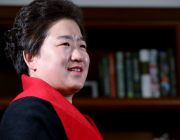Research Interests and Accomplishment
The research and accomplishments in the latest years of our group can be also summarized as four parts, including high performance triboelectric nanogenerator, hybrid energy harvesting technology, high efficiency power management technology for energy harvesting system, and self-powered active sensing technology & multi-functional smart skin.
1. High Performance Triboelectric Nanogenerators

Zhang invented the high performance Triboelectric Nanogenerators (TENGs). Developing novel energy harvesting technologies is the key for long term stability of MEMS/NEMS and IoT systems. It is highly desired for. Zhang developed the first Sandwich-typed TENG with micro-nano dual structure surface (Nano Letters, 2013, 13, 1168-1172), which has high output voltage 465V, current 107.5μA, power density achieved 53.4mW/cm3, and she introduced controllable surface treatment technologies to enlarge the friction surface and enhance surface charge density (Nano Energy, 2014, 4, 123-131; Nano Energy, 2015, 11, 304-322). She is the first investigator of surface energy by using first-principle calculations (Langmiur, 2013, 29, 10769-10775). Zhang invented the first transparent and flexible single-friction-surface triboelectric generator (STEG) (EES, 2013, 11, 3235-3240), which achieved the open-circuit voltage 130 V with a short-circuit current density of about 1mAcm-2. She developed the first electrode-free TENG for harvesting biomechanical energy from motions, the electricity can be obtained from any part of human body, The output voltage 810 V is achieved and charge over 550 nC is transferred in one step of an adult's walking (Nano Energy, 2015, 12, 19-25). Zhang demonstrated the large scale fabrication and performance enhancement strategies of TENGs based on MEMS and IC fabrication technologies (Nano Energy, 2013, 11, 1101-1106), such as DRIE and FPCB, which opened the market of TENGs in many applications.
张海霞教授采用第一性原理对摩擦材料表面电荷的形成进行了理论分析,在分子水平上揭示摩擦材料得失电子能力的本质,为摩擦发电机的性能提升奠定了理论基础【Langmiur, 2013, 29, 10769-10775】;她第一个将微纳复合结构和可控的表面处理技术【Nano Energy, 2014, 4, 123-131;Nano Energy, 2015, 11, 304-322】引入摩擦纳米发电机,大幅度提高了有效摩擦面积和表面电荷密度从而提升了发电机的性能,其中第一个三明治结构的摩擦纳米发电机的输出电压高达465V,输出电流为107.5μA,功率密度为53.4mW/cm3【Nano Letters, 2013, 13, 1168-1172】;结合人体静电模型,她在国际上实现了第一个柔性透明的单电极摩擦纳米发电机,平均输出电压峰值达到130V,而平均峰值电流密度达到了1uA/cm2【EES, 2013, 11, 3235-3240】;在此基础上,采用人体作为摩擦发电机的感应电极,她实现了无需外置电极引入的“无电极”的摩擦纳米发电机,采集人正走路的峰值电压和电流可达到810V和17.7uA,单步运动转移电荷量552nC【Nano Energy, 2015, 12, 19-25】。她率先将柔性印刷电路技术(FPCB)应用于摩擦纳米发电机的批量化制造【Nano Energy, 2013, 11, 1101-1106】,形成了工艺简单可靠、兼容性好且可以低成本生产的批量化生产技术,为产业化打下了坚实的基础。
2. Hybrid Energy Harvesting Technology

Zhang pioneered the field of hybrid energy harvesting technology. In order to harvest the environment energy in High efficiency, Zhang first invented the hybrid nanogenerator which made the simple r-shaped structure can harvest the energy both by triboelectric/piezo principle (ACS Nano, 2013, 10, 8554-8560), enhance the output of PENG and TENG can achieved 10.95mW/cm3与2.04mW/cm3 respectively. Later on, she invented the wavy-shaped structure which can drive 3 hybrid nanogenerators, it can charge a 1uF capacitor to 25V in 1mins (Nanoscale, 2017, 9, 1263-1270). In addition, Zhang developed the Magnetic-Triboelectric hybrid generator to harvest the vibration energy from all directions, it can fully charge a 20μF to 7V in 200s (Scientific Reports, 2014, 4, 4811). These research works possess unique characteristics such as the dependence of configurations, the controllable enhancing/weakening trend and amplitude, and multi-level output (AEM, 2015, 1500187), opens a window in exploring the high efficiency energy harvester to meet the needs of long term power supply.
为进一步提高微型发电机的性能,张海霞教授提出了采用复合发电原理的研究方案,首先通过摩擦电荷与压电极化电荷的耦合效应来控制压电材料两电极之间的输出,实现了高性能的摩擦-压电复合式纳米发电机【ACS Nano, 2013, 10, 8554-8560】,其压电部分与摩擦部分的输出功率分别达到了10.95mW/cm3与2.04mW/cm3;随后,她提出并实现了波浪形压电-摩擦复合式能量采集器,利用中间波浪夹层结构可以使得器件在一次按压过程同时驱动三个发电模块工作,可在1分钟时间内将1uF的电容快速充电至25V【Nanoscale, 2017, 9, 1263-1270】。此外,她还将电磁与摩擦进行复合来采集平面内任意方向振动机械能,使器件沿任意方向滑动时均可同时产生电磁和摩擦信号输出,提高机械能利用效率,器件可在200s内快速将20μF电容充电至7V【Scientific Reports,2014, 4, 4811】。复合式能量采集技术大幅度提升了能量采集效率、扩大了应用场景与适用范围【AEM, 2015, 1500187】,为微小型系统的长期供电提供了坚实的技术基础。
3. High efficiency Power Management technology for Energy harvesting system

Zhang first discovered the high efficiency power management technology for TENGs. TENG has emerging as an important approach for energy harvesting. However, low charging efficiency as well as low power conversion efficiency have restricted its practical application for powering traditional electronics, Zhang invented a power management (PM) strategy by extracting maximum energy from TENG and transferring the energy to storage unit employing optimized Inductor-Capacitor (LC) oscillating (Nano Energy, 2017, 38, 438-446). Over 2600 times improvement in stored energy than standard circuit was achieved, and more than 72% alternating current (AC) to direct current (DC) power transfer efficiency was obtained for different modes TENGs. In addition, she implemented an integrated self-charging power unit (SCPU) with a triboelectric nanogenerator and supercapacitor (JMCA, 2016, 4, 14298) which can simultaneously harvest and store energy during ambient vibration process. Several high quality supercapacitors were developed to match different applications, such as, reestanding Micro-Supercapacitor With Interdigital Electrodes for Low-Power Electronic Systems (JMEMS, 2017, 26/5, 1055-1061), All-fabric-based wearable self-charging power cloth (APL, 2017, 111, 073901), Highly Compressible Integrated Supercapacitor-Piezoresistance-Sensor System for long term health monitoring (Small, 2017, 1702091). This Power Unit provides a feasible solution for sustainable power supply and shows great potential in micro-energy fields and self-powered systems.
为解决对微型便携式设备的长期稳定供电时当务之急,张海霞教授提出了集成能量采集与存储技术的自充电能量单元,针对摩擦纳米发电机自身内阻较大难以达到阻抗匹配的难题,她提出了基于LC震荡原理的摩擦纳米发电机电源管理系统【Nano Energy, 2017, 38, 438-446】,摩擦发电机输出的交流电转换为直流输出的效率高达72%,对4.7mF电容充电的能量存储效率相比于标准模块提升2600倍,而且这种方法对不同模式的摩擦纳米发电机具有普适性。进一步,她提出将摩擦纳米发电机与超级电容集成形成自充电能量单元的解决方案【JMCA, 2016, 4, 14298】,将采集到的能量通过外部电路存储到超级电容器中,实现了外界机械能到电能的高效采集与存储,同时能够与柔性低功耗电子器件如各类传感器等相集成,实现长期稳定供电。为此,她研发了系列高性能的超级电容器,如,体积小质量轻且柔性好的采用平面式叉指结构电极的自由式微型超级电容器【JMEMS, 2017, 26/5, 1055-1061】,基于自杀菌摩擦电薄膜的高效自充电超级电容器【APL, 2017, 111, 073901】,基于多孔导电弹性体的双面微型超级电容器等等,最终她研发成功了基于通用导电织物电极的可穿戴自充电能量服【Small, 2017, 1702091】,实现了在人走路或跑步时的机械能为可穿戴技术和智能衣物的长期稳定供电。
4. Self-powered active sensing Technology & Multi-functional Smart Skin

Zhang pioneered the original idea of active sensing technology by combing electrification and electric-static and piezoelectric effect, for monitoring the weak signals, such as, position, motion, temperature, humidity, respiratory information and radial artery pulse, etc (Nano Energy, 2017, 32, 479-487; APL, 2018, 112, 203902). Zhang first proposed the self-powered analogue smart skin for detecting contact location and velocity of the object, its resolution can be achieved at 1.9 mm in 25cm3 area with only four terminals (ACS NANO, 2016, 10/4, 4083-4091). Zhang invented the first non-contact self-powered e-skin, it can serve as a human machine interface due to its ability to sense noncontact motions (AFM, 2018, 28, 1704641). Inspired by Finger anatomical structure, Zhang developed several finger-like e-skin devices, which can execute many complicated tasks and greatly expands the applications (Nano Energy, 2017,40, 65-72; AFM, 2017, 27, 1604434). Her continues discovery and breakthroughs in developing simple structure and high integration devices for self-powered active systems and push them closer to practical applications such as flexible electronics, wearable electronics, implantable device, etc. Dr. Zhang initiated the “all-in-one self-powered flexible microsystems” (Nano Energy, 2018, 47, 410-426) by introducing the technology of TENG around the following major categories: working principles, advanced materials, active sensors, actuators, et al, which has inspired the worldwide trend of integrated microsystems.
结合了摩擦起电原理与空间静电感应效应,张海霞教授提出了主动式传感技术,即利用摩擦表面与被测物体在接触中自主产生的电荷来实现对位置、运动、温度、湿度、呼吸、脉搏等微弱信号的监测【Nano Energy, 2017, 32, 479-487】【APL, 2018, 112, 203902】。她研制成功了采用二维模拟定位方法的主动式模拟电子皮肤【ACS NANO, 2016, 10/4, 4083-4091】,在平面和曲面重复测试中,在25cm3的范围内空间分辨率均达到1.9mm,可以感知蜜蜂四肢(约0.16g)落在电子皮肤上的扰动。然后从人体指纹的生理结构出发,利用多种形状(螺旋状)及性质(多孔)的导电弹性体,通过模仿人类指纹的双螺旋形状,实现了同时检测压力、滑动(方向与速度)以及粗糙度等较为复杂的自驱动行为感知【Nano Energy, 40(2017) 65–72】,【AFM, 2017, 27, 1604434】。在此基础上,她研发成功了一种新型的自驱动非接触式透明柔性电子皮肤【AFM, 2018, 28, 1704641】,能够检测垂直距离5cm以内的带电体在平行平面内的运动,空间分辨率即可达到1.5mm,可以作为实时游戏平台的人机交互界面使用。为使器件能够在各种复杂曲面上正常工作,张海霞教授提出了以纳米球、纳米线的多孔多层排布以及基于多孔海绵等来形成具有柔性可拉伸性结构【AFM, 2016, 201600909】,拉伸断裂极限可达到400%。为进一步拓展柔性系统的功能,她还以可控的方式在柔性衬底上实现硅基功能结构和器件的三维排布和组装【PNAS, 2017, 1713805114】,形成一套柔性材料与硅器件相兼容且具有可操控性的高精度三维微纳结构组装技术,为自驱动集成微系统的研究打下了坚实的技术基础。总结多年经验,2018年她提出了将发电、传感、驱动等模块进行集成的“All-in-one”综合微系统的概念(Nano Energy, 2018, 47, 410-426),在世界范围内引领了发展方向。

